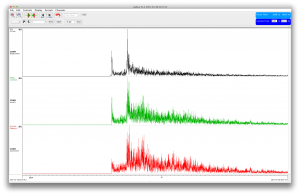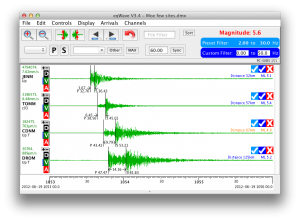You can now download the latest version of eqWave which is now known as Waves – for free by clicking here, and you can remove the pop-up ads by purchasing a single installation licence for only A$110.
Wave is a super user-friendly earthquake waveform viewer that allows you to pick earthquake wave arrivals from dozens of seismograph stations in a single view, see frequency spectra, convert between velocity, acceleration and displacement, and much more. The short video below shows the user interface and some of the basic features.
Waves interacts with eqFocus for simple earthquake location and magnitude calculation. Waves is available for Windows, Mac and Linux (Java required) and is provided with an pop-up ad-removal key with any Kelunji seismograph purchase.
 Download the User Manual that showcases all of the application’s features in detail.
Download the User Manual that showcases all of the application’s features in detail.
There are some great features in eqWave, including vector sum calculations. Simply click on a channel, select the Triaxial Group Vector Sum function from the Display menu and you are presented with a new window containing a vector sum trace of acceleration, velocity, and displacement.
 Calculating local Richter magnitude has never been easier. Simply pick a P & S wave arrival! The distance to the earthquake and the peak displacement is calculated, and the MLv is displayed. When you have multiple stations, magnitudes are averaged, outliers excluded, and the estimated magnitude displayed at the top of the screen.
Calculating local Richter magnitude has never been easier. Simply pick a P & S wave arrival! The distance to the earthquake and the peak displacement is calculated, and the MLv is displayed. When you have multiple stations, magnitudes are averaged, outliers excluded, and the estimated magnitude displayed at the top of the screen.
eqWave can now open and save MiniSEED format files and can also read and stack SEG-Y format data. Due to the minimalist nature of these formats, some Waves features are not available, but you can enter the response data into the channel properties so that you can view ground motion units and correct magnitudes. Other features and tweaks in the latest versions of eqWave include:
- unified settings screen
- display 24 hours of data on screen
- drag and drop folders of data to auto-merge to screen
- sort stations by distance from closest station
- larger station codes for better legibility
- new keyboard shortcuts
- minor clean-ups and bug fixes
